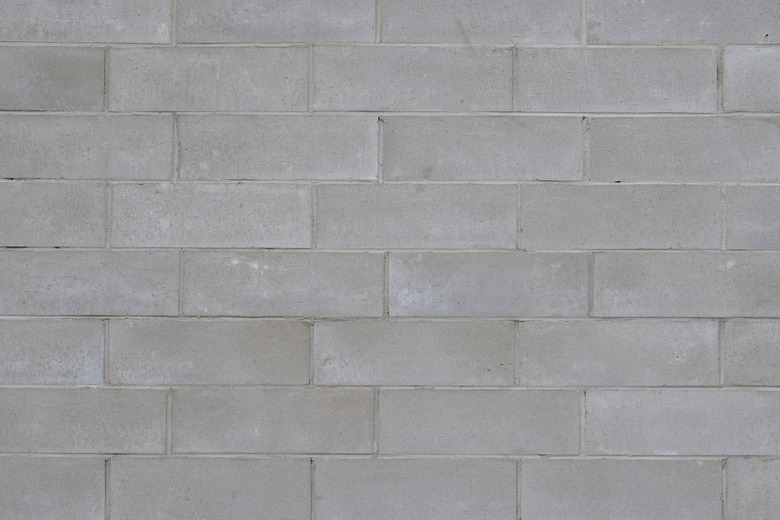Types Of Concrete Block Fences
Step 1
Basic concrete mortar block is the type of block most people associate with block wall construction. There are three types of basic concrete mortar block: gray block, split face block and exposed aggregate block. Gray block, also known as the "basic building block" of industry, is used in applications where aesthetics and beauty are not the primary concern. Gray blocks are installed using mortar, and are reinforced with steel in the interior channels. Split face blocks are essentially gray blocks that have been altered to produce a rough, uneven surface on the exposed face of the block. Split face blocks are made by pouring concrete into a double mold. They are physically split apart after curing to produce two blocks. Split face blocks are installed the same way as gray block. Exposed aggregate block is concrete block that has been sand-blasted after curing. This process exposes the aggregate within the concrete, and provides a visually appealing texture on the block face.
Step 2
- Basic concrete mortar block is the type of block most people associate with block wall construction.
- Split face blocks are essentially gray blocks that have been altered to produce a rough, uneven surface on the exposed face of the block.
Advanced Mortar Concrete Block
Step 1
Advanced concrete mortar blocks are constructed to achieve unique visual effects when combined in a wall. This block type includes slump block, and Sonora or fluted block. Slump block is a type of concrete block that mimics the look of adobe. It is uniform in size and shape but gives the appearance of irregularity. This block is also available in different size and color combinations. The manufacture of Sonora and fluted block uses molds that create vertical lines and a textured face in the finished block. Sonora and fluted concrete block are popular with architects and designers. This type of block provides an inexpensive way to create unusual lines and textures in walls.
Step 2
- Advanced concrete mortar blocks are constructed to achieve unique visual effects when combined in a wall.
- This type of block provides an inexpensive way to create unusual lines and textures in walls.
Non-Mortar Concrete Block
Step 1
Three types of block do not require of mortar to hold them together. Rather, a system using gravity and special design characteristics keeps the wall intact. Non-mortar concrete blocks include landscape masonry, interlocking AB, and interlocking fence block. Landscape masonry is a mortarless concrete block system that has specialized uses, and is favored by architects because of the variety of block shapes and colors, and the ease of installation. Landscape masonry can be used as pavers for walkways, or to create landscape retaining walls (up to 6 feet high without reinforcement). Interlocking mortarless AB concrete block is a stackable block system used to create visually appealing walls. Only one company currently manufactures AB blocks. AB blocks are extremely popular with contractors, and are available from any masonry supplier. AB blocks are available in a variety of sizes, shapes and colors. Interlocking fence block is a hybrid in terms of installation. Mortar is used on the horizontal joint, but not on the vertical joint between blocks. The blocks connect using a tongue-and-groove design at each end of the block. These blocks are available in a variety of textures and colors, and are used primarily for fence applications.
Step 2
- Three types of block do not require of mortar to hold them together.
- Landscape masonry is a mortarless concrete block system that has specialized uses, and is favored by architects because of the variety of block shapes and colors, and the ease of installation.
Pre-Cast Concrete Walls
Step 1
Pre-cast concrete walls are the most expensive method of constructing concrete block walls. Pre-cast concrete walls are made in large sections, transported to the job site, and installed by a licensed contractor. The variety of shapes, textures, and color combinations are practically limitless.
Construction Considerations
Step 1
All concrete block walls require foundation construction (or a footing) with one exception. Landscape masonry retaining walls less than 5 feet tall do not require a footing. Footings are typically constructed of poured concrete, reinforced with steel rebar, and finished so that there is a level base from which to build the wall. Hollow, concrete blocks are designed to provide for steel reinforcement, which is directly connected to the steel in the footing. Concrete is then poured into the interior channel of the wall with the steel in it. This process helps maintain the wall's strength and rigidity where external forces may act upon the wall.
Step 2
- Pre-cast concrete walls are the most expensive method of constructing concrete block walls.
- Hollow, concrete blocks are designed to provide for steel reinforcement, which is directly connected to the steel in the footing.
